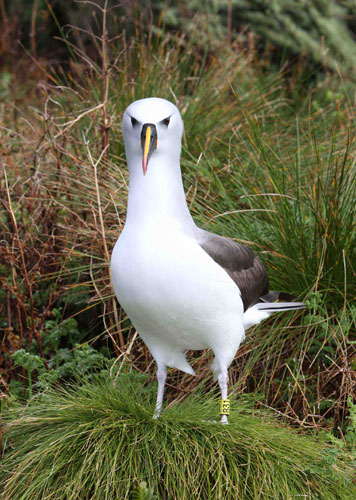Aboard is a combined Royal Society for the Protection of Birds (RSPB) and University of Cape Town team to continue conservation activities on Gough. These include the monitoring of Atlantic Yellow-nosed Thalassarche chlororhynchos and Tristan Diomedea dabbenena Albatrosses and Southern Giant Petrels Macronectes giganteus. For each of these three ACAP-listed species colour-banded populations in study colonies are being followed.

In addition, efforts will continue to eradicate the introduced plant, Procumbent Pearlwort Sagina procumbens from the coastal cliffs at the weather station in Transvaal Bay.
This year the nine-person expedition is being led by John Cooper in his capacity as an honorary Tristan Conservation Officer. Two rope-access climbers will work on plant eradication and two young Tristanians will join us from Tristan to help out and gain experience. Two French researchers employed by the RSPB will be left on the island for a year to continue data collection on selected species of seabirds and land birds.
An important part of the work load during the relief period will be conducting the annual island-wide census of Tristan Albatross chicks. Once more it is expected that too few will be found to sustain the global population, following the now all-to-familiar predation of downy chicks of this Critically Endangered species during successive winters by the island's alien "killer" House Mice Mus musculus.
On our way to Gough, Peter Ryan (FitzPatrick Institute, University of Cape Town) and two colleagues will be dropped off at Inaccessible Island in the Tristan group for three weeks to conduct research on the island's buntings. It is expected that they will also be able to check whether the single pair of Tristan Albatrosses on the rodent-free island has hatched its egg and if so, that the chick has survived the winter (click here for an earlier story).
This will be last year the S.A. Agulhas will visit Tristan and Gough. Next year, its replacement now being built in Finland, the S.A. Agulhas II, will replace her on the run.
Gough and Inaccessible Islands and their territorial waters are nature reserves and Ramsar Wetlands of International Importance, and together form a single World Heritage Site.
Conservation research on birds and management activities on Gough are funded by the UK's Overseas Territories Environment Programme via the Royal Society for the Protection of Birds and are conducted with the support and approval of the Tristan Conservation Department.
John Cooper, ACAP Information Officer, 11 September 2011

 English
English  Français
Français  Español
Español